

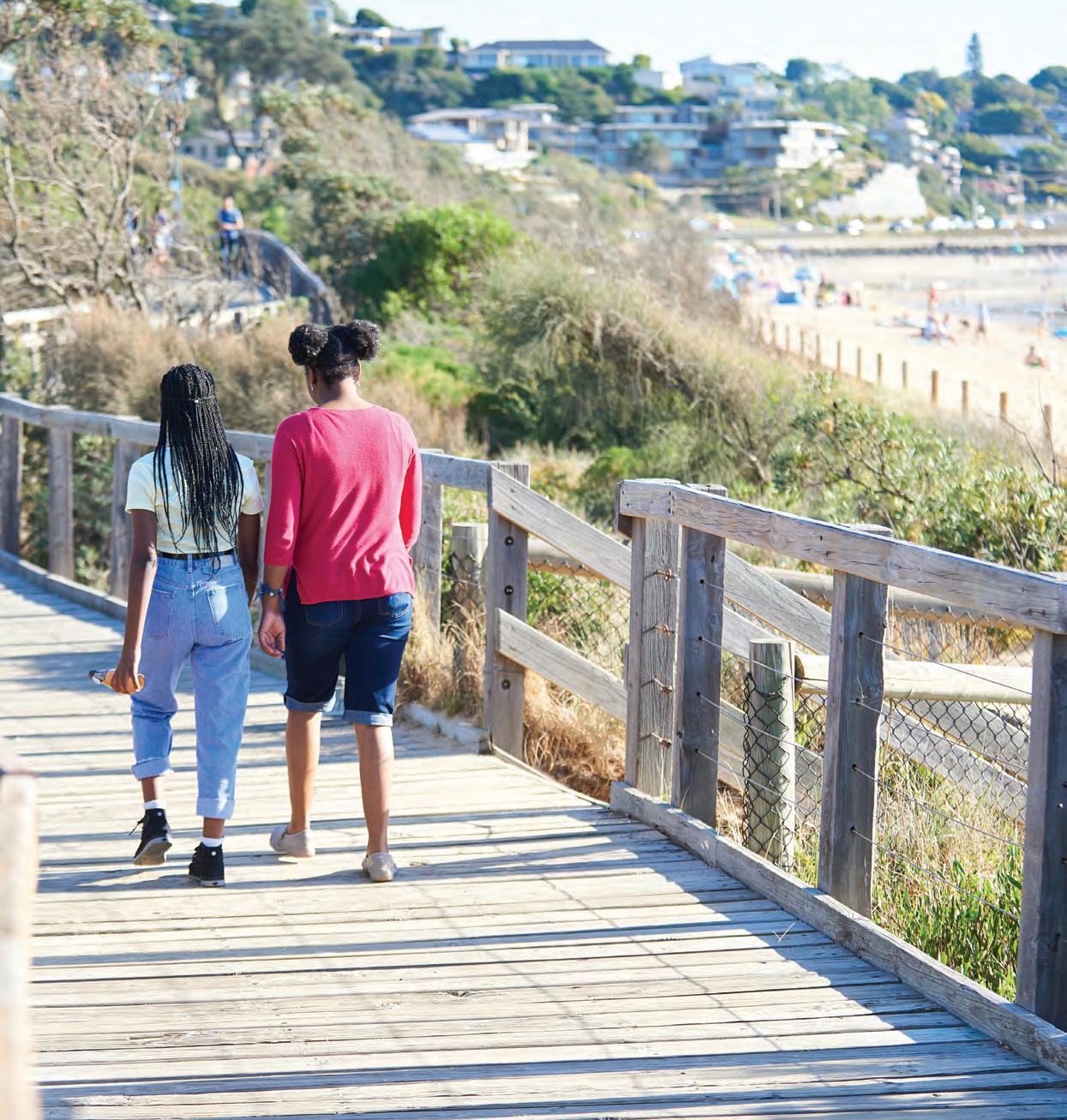
Capital of Victoria
Lifestyle
Acknowledgement of Country
Frankston City Council acknowledges the Bunurong people of the Kulin Nation as the Traditional Custodians of the lands and waters in and around Frankston City, and value and recognise local Aboriginal and Torres Strait Islander cultures, heritage and connection to land as a proud part of a shared identity for Frankston City.
Council pays respect to Elders past and present and recognises their importance in maintaining knowledge, traditions and culture in our community.
Council also respectfully acknowledges the Bunurong Land Council as the Registered Aboriginal Party responsible for managing the Aboriginal cultural heritage of the land and waters where Frankston City Council is situated.
2
3 Contents Message from the Mayor ………4 Executive Summary………………………………………………………………………………………………..………..…….6 Our priorities and objectives About our Health and Wellbeing Plan………………………………………………………………………..……….…8 Legislative requirements Our integrated planning approach to health and wellbeing……………………………………………….….9 Our shared outcomes Our Community Vision 2040 Our policy domains Alignment with Victorian Health and Wellbeing Plan Our role in health and wellbeing…………………………..…………………………………………….…….…………15 Working in partnership Determinants of health Health inequalities and intersectionality – our focus populations Our community profile 20 Our health and wellbeing profile……..……………………………………………………………………………….….23 Priority 1: Building healthy and active communities……………………………………………………………27 Priority 2: Building fair and inclusive communities…………………………………………….…………….…34 Priority 3: Increasing mental wellbeing and resilience…………………………….……………………….…39 Priority 4: Strengthening climate action for community wellbeing .44 Priority 5: Strengthening gender equality and respectful relationships……………………………..48 Priority 6: Building safe communities……………………………………………………………………………….…54 Delivering the Health and Wellbeing Plan……………………………………………………………………………59 Implementation Monitoring and evaluation References
Message from the Mayor
As Mayor of Frankston City, I am pleased to present the Health and Wellbeing Plan for 2021-2025. This Plan will be integral to us working collaboratively with our community and partners towards a liveable, innovative and proud City where each person has equal opportunity to live a long and healthy li fe.
Over the course of a person’s life, factors such as support in the early years, levels of education and security of food, employment and housing will have an impact on their health and wellbeing.
Although the majority of people in Frankston City are living healthily and reporting similar levels of wellbeing to other Victorians, it’s important to acknowledge that this is not the experience of all members of our community. Frankston City has more cases of obesity, diabetes, heart disease and people living with one or two chronic diseases than the Victoria average. Rising experiences of mental health challenges (including as a result of COVID-19) are also concerning.
When health is a persistent challenge, it not only impacts on an individual’s ability to take up opportunities and improve their life chances, it can also affect their families and many of those around them.
Local governments are directly connected to their communities, making them uniquely placed to promote positive social influences and create environments that foster better health and wellbeing the foundation for a good life. Through our role in planning and designing liveable neighbourhoods we can create environments that foster inclusive and resilient communities that are supported to take positive actions to reduce risks to their health.
These positive choices may include exercising and socialising more due to improving facilities, smoking less because there are less public places where doing so is permitted and choosing venues which lessen the likelihood of problem gambling because they are open in the evening.
This Health and Wellbeing Plan further expands on how Council will encourage active and healthy lifestyles, with a focus on well-planned neighbourhoods that encourage walking and cycling, access to high quality open spaces, the provision of community amenities that are welcoming and culturally safe, and universally accessible services.
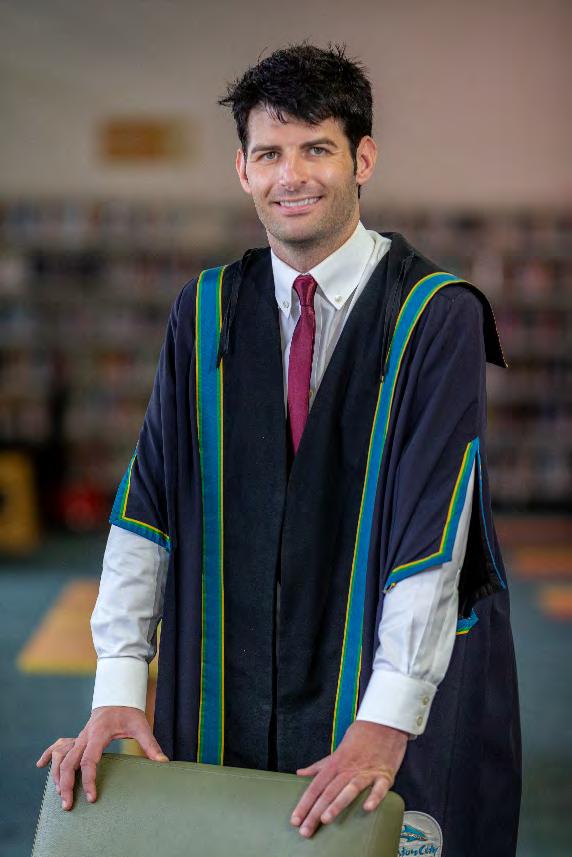
4
We have developed six priorities and multiple objectives to drive action that includes improving opportunities for active travel, improving access to open spaces and recreation opportunities, support for good nutrition, opportunities that build social inclusion and community connections, responses to health issues arising from climate change, and support for healthy and sustainable homes, buildings and public spaces.
The Plan identifies how Council will also address family violence by strengthening prevention as a priority in universal services and promoting respect and inclusion to reduce elder abuse and encourage gender-equitable workplaces, services and programs.
You will also see in this document how safe public spaces, positive cultures, strong partnerships and smoke-free communities can be built to reduce harms from
gambling, smoking, alcohol and other drugs.
The Plan was created in partnership with staff, community health agencies and through community consultation, and draws on extensive research to analyse and understand our community’s health and wellbeing needs.
I believe the priorities and objectives in this Plan, identified for targeted action over the next four years, will put us all on a path to better health and prospects.
 Cr Kris Bolam Mayor, Frankston City
Cr Kris Bolam Mayor, Frankston City
5


The Health and Wellbeing Plan 2021–2025 is Frankston City Council’s strategic plan for how we will work with our partners over the next four years to create well planned and liveable environments with healthy, strong and safe communities so everyone has the equal opportunity to enjoy good health and wellbeing at every stage of life.
In accordance with the Public Health and Wellbeing Act 2008, the Plan has been developed to provide a clear strategic direction on the health and wellbeing priorities for the Frankston City community, and lead coordinated and collaborative action across the municipality
The Plan was developed in consultation with the community and in collaboration with our partners, and informed by health population data and social research.
The Plan enables Council and our partners to understand the evidence on the most pressing health and wellbeing issues and health inequities within Frankston City that require the strongest focus to guide planning, service delivery and collaborative action.
In delivering the Plan, Council will place primary prevention at the heart of what we do, taking a systemic approach to the design, planning and delivery of our policies, universal services, infrastructure, recreation facilities, activity centres and open spaces to enhance opportunities for our community to be as healthy as possible.
The Plan aligns with the Community Vision 2040, Council Plan 2021-2025 and Municipal Planning Strategy to ensure that health and wellbeing outcomes are integrated with the longterm vision for Frankston City and reflect the community’s needs.
The Plan has been developed within the context of the ongoing impacts of the COVID-19 pandemic, which has affected every member of our community and for some has resulted in widening health inequities. The Plan aims to take an intersectional approach to addressing health inequities across all stages of life.
The Plan will be implemented through an action plan that is reviewed and updated annually throughout the Plan’s four-year lifecycle. This process aims to ensure that the Plan remains dynamic, relevant and responsive to the changing policy environment and our community’s needs.
6
Our health and wellbeing priorities
Priority 1
Building healthy and active communities
1.1 Improve opportunities for walking, cycling and active travel
1.2 Improve access to public open spaces, play spaces and recreation facilities
1.3 Improve access to inclusive club sports and active recreation activities
1.4 Improve healthy eating and food security to support good nutrition across the life course
Priority 3
Increasing mental wellbeing and resilience
3.1 Support opportunities to build social inclusion and community connection
3.2 Increase volunteering and community participation
3.3 Foster social cohesion and community harmony
Priority 5
Strengthening gender equality and respectful relationships
5.1 Build partnerships to prevent family violence, violence against women, and elder abuse
5.2 Strengthen equitable, safe and respectful relationships
5.3 Create gender equitable workplaces, services and programs
Priority 2
Building fair and inclusive communities
2.1 Partner and advocate to reduce health inequities, poverty and disadvantage
2.2 Partner and advocate to improve equitable access to education, employment and housing
2.3 Strengthen relationships to support Aboriginal self-determination and reconciliation
Priority 4
Strengthening climate action for community wellbeing
4.1 Increase awareness of the health impacts of climate change
4.2 Strengthen response to public health threats and emergencies for vulnerable communities
4.3 Support healthy and sustainable homes, buildings and public spaces
Priority 6
Building safe communities
6.1 Create safe public spaces through Council policy, planning and design
6.2 Build partnerships that change cultures and reduce harms from alcohol and other drugs and gambling
6.3 Create smoke free communities
7



for how we will work with our partners over the next four years to create well planned and liveable environments with healthy, strong and safe communities so everyone has the equal opportunity to enjoy good health and wellbeing at every stage of life. The Plan provides a framework for an integrated approach to addressing health and wellbeing within Frankston City.
Legislative requirements
Under the Victorian Public Health and Wellbeing Act 2008, Council has a statutory obligation to prepare a Municipal Health and Wellbeing Plan within 12 months of each general election. The plan must:
Include an examination of data about health status and health determinants within the municipality
Identify goals and strategies based on available evidence for creating a local community in which people can achieve maximum health and wellbeing
Provide for the involvement of people in the local community in the development, implementation and evaluation of the plan
Specify how Council will work in partnership with agencies undertaking public health initiatives, projects and programs to accomplish the goals and strategies identified in the plan
Be consistent with the Council Plan and Municipal Strategic Statement
Have regard to the Victorian Public Health and Wellbeing Plan
In addition, the plan must provide for the following requirements:
The Victorian Climate Change Act 2011, which requires Council to consider climate change during the preparation of a Municipal Health and Wellbeing Plan
The Royal Commission into Family Violence Recommendation 94, which requires that councils report on the measures they propose to take to reduce family violence and respond to the needs of victims in preparing their Municipal Health and Wellbeing Plans
8


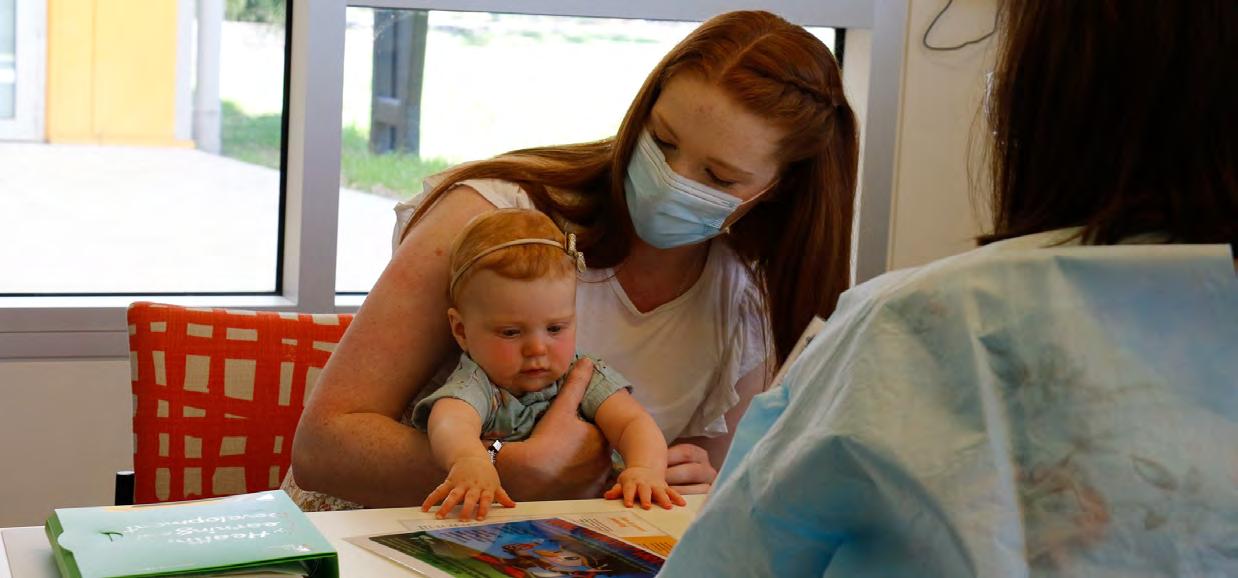
Council is taking an integrated planning approach to the development of its policies, strategies and plans to ensure that we are working towards a set of shared outcomes that incorporate a long-term view of our community’s desired future for the municipality.
This approach has been formalised through the introduction of Council’s Integrated Planning and Reporting Framework, which connects our community’s long-term aspirations in the Community Vision 2040 with Council’s long-term resourcing strategies and medium term strategic plans and policies, and in particular with the Council Plan and Budget.
This connection forms a ‘golden thread’ through our plans to strengthen our journey towards achieving our shared outcomes.
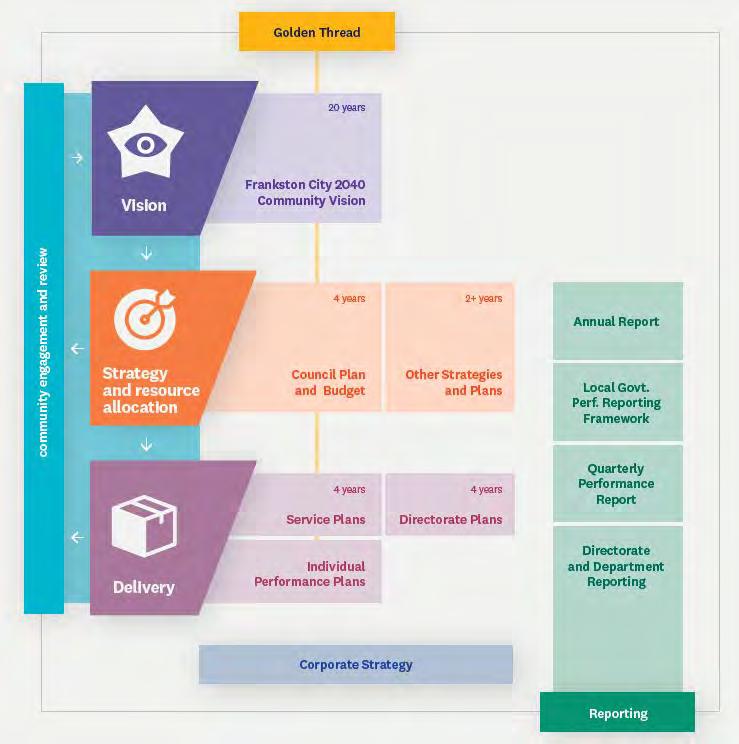
9
Figure 1: Frankston City Integrated Planning and Reporting Framework
Our shared outcomes
Our Council Plan 2021-2025 sets our shared outcomes for the next four years, which in addition to being aligned with the Community Vision 2040 are also aligned with Council’s policy domains (long-term outcomes). These policy domains are used by Council as a policy framework to guide the development of its policies and strategies, also forming part of the ‘golden thread’.
The Health and Wellbeing Plan has been developed to align with our shared outcomes to ensure it will work towards the achievement if Frankston City being recognised as liveable, innovative and a proud City
10 YEARS +
Policy domains
Healthy Community
Sustainable environment Safe Community Community Strength
Stronger Families
Community Vision 2040 themes
Healthy families and communities
Healthy and safe communities
Vibrant and inclusive communities
Natural environment and climate action
4 YEARS
Connected places and spaces
Council Plan outcomes
Community Strength Sustainable environment
Sustainable economy Skilled Community
Industry, employment and education
Advocacy, governance and innovation
Well planned and liveable City
Thriving economy Progressive and engaged City
10
Table 1: Our shared outcomes
Our Community Vision 2040
The Frankston City Community Vision 2040 is our community’s long-term vision and aspirations for the future of our City, providing a description of what our community wants for the future of our municipality, in terms of its look, feel and liveability.
The Community Vision 2040 sets the direction for our whole community, inspiring us all to work together to create a future for our City that our community wants to see, live and experience.
Our Community Vision
Frankston City 2040 is the place on the bay to learn, live, work and play in a vibrant, safe and culturally inclusive community. Our City is clean, green and environmentally responsible.
Our Community Vision 2040 was created through a deliberative engagement process with a representative community panel of residents, and is voiced in their own words.
The Community Vision 2040 forms part of Council’s strategic planning and reporting framework, ensuring it incorporates a long-term view of the community’s desired future into strategic planning and decision making. In particular, the Community Vision 2040 helped to shape the Council Plan 2021-2025 and will guide future Council planning across the next 20 years.
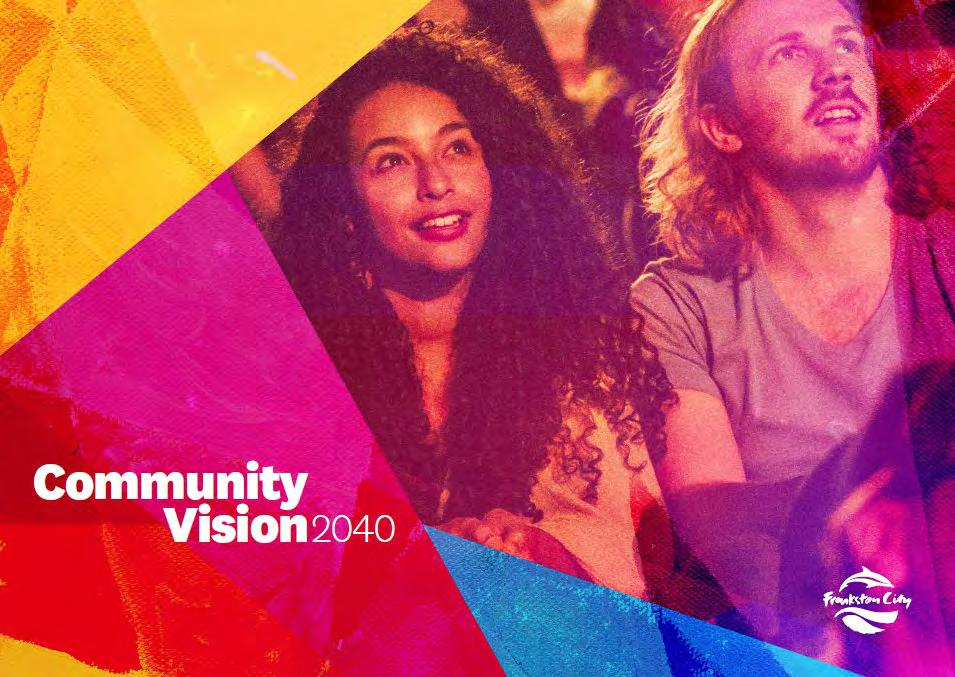
11
Community aspirations
The aspirations from the Community Vision 2040 have been used to help guide our health and wellbeing priorities and objectives.
10 YEARS + 4 YEARS
Community Vision 2040
Themes and aspirations
Healthy families and communities
Frankston City empowers everyone to improve their health and wellbeing through access to green space, quality health services, social supports, education and opportunities to be physically active.
Connected places and spaces
Frankston City is a well-connected and safe community with a unique identity, recognised for its vibrant City Centre that capitalises on its natural assets and heritage. Frankston City is the place that people want to visit, study, work and live in.
Vibrant and inclusive communities
The community is proud of First Nations Peoples heritage and culture, and promotes a sense of pride and belonging for the local Aboriginal and Torres Strait Islander community. Frankston City is known as a cultural hub with a thriving arts community, embracing diversity and promoting wellbeing.
The natural environment and climate action
Frankston City is green and sustainable, and a leader in sustainable industry and development. Both Council and community are committed to protecting and enhancing the environment and actively addressing climate change.
Council Plan 2021-25 Outcomes
Healthy and safe communities
Active and healthy lifestyles that support residents living independently longer
Long-term health and learning outcomes established in early childhood
Reduction of harms from family violence, gambling, alcohol and other drugs
Well planned and liveable city
Urban design renewal of public places and spaces
Connected, accessible, smart and safe travel options
Health and Wellbeing Plan Priorities
Building healthy and active communities
Strengthening gender equality and respectful relationships
Building safe communities
Building healthy and active communities
Community strength
Accessibility of services to enhance social inclusion and mental wellbeing
Volunteering to build connections and resilience within the community
Frankston City’s arts and cultural identity
Sustainable environment
Climate emergency response and leadership
Green canopy cover to reduce urban heat
Diversion of waste from landfill Protection, access and connection to the natural environment
Increasing mental wellbeing and resilience
Building fair and inclusive communities
Strengthening climate action for community wellbeing
12
Our policy domains
Our policy domains (long-term community outcomes) are based on key indicators of health and liveability, expressed in our Community Building Outcomes Framework

Our framework draws from a number of key theoretical approaches to enable Council to develop a deep understanding of our community, where and how to best use resources, improve service delivery, form partnerships and build social capital to affect long-term positive change. When applied, the Framework facilitates a place-based planning approach to the development of key prevention and early intervention strategies and initiatives that are integrated into Council’s universal service delivery system and management of community infrastructure.
13
Figure 2: Frankston City Community Building Outcomes Framework
An integrated approach to health and wellbeing
Our Health and Wellbeing Plan provides a framework for our integrated policy and planning approach to addressing health and wellbeing within Frankston City to ensure a collaborative approach to improving outcomes.
The Plan closely aligns with our key strategies to direct resources and influence the achievement of co-health benefits and health outcomes within the areas prioritised in the Plan, ensuring a whole-of-organisation and systems approach
The Plan also aligns with our action plans developed for different population groups and issues, providing direction to deliver actions that improve health and wellbeing outcomes.
Health and Wellbeing Plan
2021-2025
Strategies
Municipal Planning Strategy
Leisure Strategy
Play Strategy
Climate Change Strategy
Open Space Strategy
Integrated Transport Strategy
Housing Strategy
Economic Development Strategy
Community Safety strategy
Disability Action Plan
Municipal Early Years Plan
Youth Action Plan
Positive Ageing Action Plan
Action Plans
Family Violence Prevention Action Plan
Reconciliation Action Plan
Healthy, Secure and Sustainable Food Action Plan
14
Alignment with the Victorian Health and Wellbeing Plan
Frankston’s Health and Wellbeing Plan has also been guided by the Victorian Public Health and Wellbeing Plan 2019-2023 and the following priorities to improve all Victorian’s health and wellbeing:
Increasing active living
Increasing healthy eating
Tackling climate change and its impact on health
Reducing tobacco-related harm
Improving mental wellbeing
Preventing all forms of violence
Reducing harmful alcohol and drug use
Reducing injury
Focus areas
Decreasing the risk of drug resistant infections in the community
15



Local government plays an important role in improving health and wellbeing within communities. With a key role in the planning, design and development of land, local government can influence liveable neighbourhoods and environments that foster inclusive and sustainable communities and promote physical and psychological wellbeing. Local government also works as a direct service provider and partner in the provision of universal services, infrastructure and public spaces to enhance community wellbeing.
This Plan will strive to ensure that Frankston City’s local communities are well-planned and liveable so people can enjoy good health and wellbeing through Council’s role as: Service provider
Provide universal services across all life stages, including: early years services; youth services; community centres; libraries; aged care and disability services; arts and cultural programs, major events and festivals.
Local leader, partner and advocate
Planner
Local laws, building surveyor and environmental health enforcer
Community builder
Planner of services, recreation, infrastructure and the environment, and economic development, town planning and social and community planning.
Uphold compliance with local laws, animal management and inspects food premises.
Engage the community into a diverse range of programs and activities that build capacity, and provide community development, community grants and networks.
Manager
Information provider
Facilitate partnerships and collaborative action between the community, government, services, not-for-profit, education and private sectors to create positive outcomes for the municipality.
Manager of infrastructure, waste and recycling, the environment, recreation and open space providing, maintaining infrastructure and open spaces.
Provide information and referrals to community services, opportunities, events, activities and places.
Employer
Encourage the development of staff to deliver high quality services to the public.
16
Working in partnership
Council has an ongoing commitment to working in partnership in order to deliver improved health and wellbeing outcomes for the community.
Our key health partners in the Frankston City community include (but are not limited to) the following:
Peninsula Health
Frankston Mornington Peninsula Primary Care Partnership
South East Melbourne Primary Health Network
The major provider of clinical and community health services in Frankston City and the Mornington Peninsula.
Fosters connection between local government, clinical and community health services and community agencies, and assumes major responsibility for health promotion in Frankston and on the Mornington Peninsula.
Funded by the federal government with the key objectives of increasing the efficiency and effectiveness of medical services for patients, particularly those at risk of poor health outcomes, and improving coordination of care.
Women’s Health in the South East
Bunurong Land Council Aboriginal Corporation
Government departments
Victoria Police
Not for profits and community groups
Advisory groups
Works to improve the health and wellbeing of women in the Southern Metropolitan Region of Melbourne and focuses on two main priority areas: sexual and reproductive health, and mental health including the prevention of violence against women.
The area’s Registered Aboriginal Party, a Traditional Owner organisation representing the Bunurong people of the SouthEastern Kulin Nation.
Including (but not limited to) Department of Health, Department of Transport, Department of Environment, Land and Planning and VicRoads
Upholds the law to promote a safe, secure and orderly society.
Independent groups providing important community services to the community.
Including the Disability, Access and Inclusion Committee, Positive Ageing Ambassadors and Youth Council.
17
Determinants of health
According to the World Health Organisation, the social conditions in which people are born, live and work is the single most important determinant of good health or ill health. i Over the course of a person’s life these key determinants of health have a cumulative effect on health and wellbeing as they interact and accumulate. ii
This Plan has been prepared within the context of following the key determinants of health, taking into account how they interact with each other to impact long-term health and wellbeing and drive health inequity:
Social, economic and cultural environments:
Early life
Education
Employment and work
Household income
Housing and geography
Food security
Access to health services
Social support networks
Social norms and attitudes
Exposure to crime
Connection with culture
Access to leisure
Natural and built environments:
Transport and business infrastructure
Community infrastructure
Roads and paths
Safe design
Open space and biodiversity
Housing density
Biomedical and behavioural risk factors:
Family history (blood pressure, blood lipids, blood glucose, etc.)
Smoking
Alcohol consumption
Illicit drugs
Poor diet
Sedentary lifestyle

18
Figure 2: Framework for determinants of health
Source: Dahlgren G & Whitehead M 1991 Policies and strategies to promote social equity in health, Institute for Future Studies, Stockholm.
Health inequities and intersectionality – our focus populations
A key challenge for local government is to promote health equality across the municipality, ensuring that all population groups within the community have fair and equitable access to services, infrastructure, programs and open spaces that promote health and wellbeing, enabling an equal opportunity to be as healthy as possible
Health inequities are differences in health status between population groups that result from social, economic and geographical influences that are avoidable, unfair and unnecessary. iii Social inequality and disadvantage are the main reasons for avoidable and unfair differences in health outcomes.
Health equity therefore is the notion that all people should have a fair opportunity to attain their full health potential, and that no one should be disadvantaged from achieving this potential if it can be avoided. iv Focussing on health equity allows Council to orient resources and supports to the people who need them the most, how and where they need them.
This Plan will aim to address health inequities across all stages of life through an equity approach.
Population groups at risk of health inequities that will be a focus in this Plan:
• Aboriginal and Torres Strait Islander peoples
• People with disabilities or chronic health problems
• Women
• People experiencing socio-economic disadvantage
• People from culturally and linguistically diverse backgrounds
• Older people
• LGBTQIA+
The Plan also considers intersectionality and how different asepcts of a person’s identity can lead to overlapping discrimination and marginalisation.
The COVID-19 pandemic has had a wide ranging health, social and economic impact, working to widen the health inequities being experienced within our population.
19


Frankston City is located on the eastern shores of Port Phillip Bay within Metropolitan Melbourne, approximately 40 kilometres south of Melbourne CBD. The municipality covers an area of about 131 square kilometre. Our City is known for its 11 kilometres of pristine coastline, award-winning beaches and natural bushland, vibrant lifestyle and growing business, arts, education and health facilities.
Frankston City is made up of the following eleven local communities, each with their own unique needs: Carrum Downs, Frankston Central, Frankston Heights, Frankston North, Frankston South, Karingal, Langwarrin, Langwarrin South, Sandhurst, Seaford and Skye.
The Traditional Custodians of the land in and around Frankston are the Bunurong peoples, part of the language group known as the Kulin nation. The country of the Bunurong peoples extends from Werribee Creek to the Tarwin River and Wilson’s Promontory.
Our community profile has been developed from the .id community profile, and based on the Australian Bureau of Statistics 2016 Census.
Map: Frankston City Local Government local areas

To view a detailed health and wellbeing profile, please visit: www.frankston.vic.gov.au/healthandwellbeing
20
Population density = 11 people per hectare
2041 projected resident
12.07% growth from 2021 to 2041


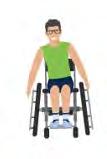
1% of the resident population

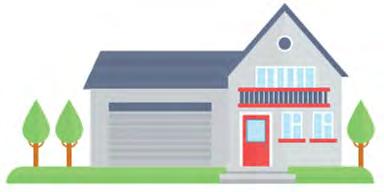
21
Higher than Greater Melbourne average
Lower than Greater Melbourne average
2020 estimated resident population
population
2016 median age
2016 resident population with a disability (7,227 residents)
2016 residents identifying as Aboriginal and Torres Strait Islanders
2016 couples with children households
2016 couples without children households
2016 one parent family households
2016 resident population born overseas
2016 resident population speaking a language other than English at home
2016 resident population identifying as belonging to a faith group
2016 resident population stating no religion
2016 SEIFA index of disadvantage
2016 low income households
2016 medium and high density housing
2016 lone person households


22
2016 households renting
2016 households with a mortgage
2016 households living in rental stress
2016 households living in mortgage stress
2016 resident population attending university
2016 resident population with a university qualification
2016 resident population with a trade qualification
2016 resident workforce participation
2016 resident population using public transport to work
2016 young residents that were disengaged (15 to 24 years of age)
2016 households with two or more cars
Our health and wellbeing profile

The majority of people in Frankston City are living in relative good health. However research shows that there are some key issues in the municipality that are having a significant impact on health and wellbeing, with these issues being felt more acutely within population groups that experience health inequities.
Increasing over time in Frankston City Decreasing over time in Frankston City
Health status
2017 Victorian Population Health Survey
Self-reported health status

Resident population reporting their health as being good, very good or excellent
Victorian average 79.2%
Body weight status
Resident population who are overweight or obese
Victorian average 50.8%
Women’s self-reported health status
Victorian average 78.1%
Men’s self-reported health status
Victorian average 79.7%
Women who are overweight or obese
Victorian average 43.7%
Men who are overweight or obese
Victorian average 58.2%
23
Mental wellbeing
2017 Victorian Population Health Survey
Depression and anxiety
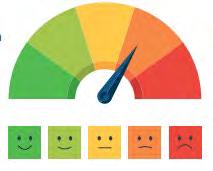
Resident population who have ever been diagnosed with depression or anxiety
Victorian average 27.4%
Psychological distress
Resident population reporting high or very high levels of psychological distress
Victorian average 15.4%
Health conditions
2017 Victorian Population Health Survey
Type 2 diabetes
Resident population reporting they have been diagnosed by a doctor
Victorian average 5.4%
Heart disease
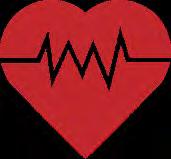
Resident population reporting they have been diagnosed by a doctor
Victorian average 6.7%
Women ever diagnosed
Victorian average 33.5%
Men ever diagnosed
Victorian average 21%
Women reporting high or very high levels
Victorian average of 18%
Men reporting high or very high levels
Victorian average of 12.8%
Women with Type 2 diabetes
Victorian average 4.6%
Men with Type 2 diabetes
Victorian average 6.3%
Women with heart disease compared with the state average of 5.4%
Men with heart disease
Victorian average 8.2%
24
Cancer

Resident population reporting they have been diagnosed by a doctor
Victorian average 8.1%
Health behaviours
2017 Victorian Population Health Survey
Smoking
Resident population reporting as being a current smoker
Victorian average 16.7%
Lifetime risk of alcohol related harm
Resident population at increased lifetime risk of alcohol related harm
Victorian average 59.5%
Healthy eating

Resident population reporting that they consume the recommended serves of fruit and vegetables per day
Victorian average 3.6%
Women with cancer compared with the state average of 8.4%
Men with cancer compared with the state average of 7.6%
Women who currently smoke
Compared with that state average of 13.2%
Men who currently smoke
Compared with the state average of 20.3%
Risk of alcohol related injury
Resident population at increased risk of alcohol related injury from a single occasion of drinking
Victoria average 43%
Sugary drinks
Resident population reporting that they consume sugary drinks daily
Victorian average 10.1%
25
Physical activity
Resident population engaging in sufficient levels of physical activity
Victorian average 5.9%
Active transport
Resident population traveling to work or study by public transport, walking or cycling
Victorian average 17%
ABS 2016 Census
Impacts of COVID-19 pandemic
Women meeting guidelines compared with the state average of 49%
Men meeting guidelines compared with the state average of 52.8%
Gambling
Amount spent on pokies per day in 20192020
Victorian Responsible Gambling Foundation
The COVID-19 pandemic has had an impact on the health and wellbeing of the community, the effects of which are likely to be felt for many years to come, particularly for those groups hardest hit.
One of the most comprehensive studies conducted on the health and wellbeing of Victorians has been the VicHealth Coronavirus Victorian Impact Study, which has tracked the impact of the pandemic on people’s health and wellbeing. The results from this study has demonstrated that that the following groups have experienced the most significant health and wellbeing impacts compared to the Victorian population overall:
• People who are unemployed, includes both people who were unemployed prior to the pandemic and those who have lost a job/opportunities to study due to the pandemic
• Young people aged 18 to 35 years
• People on low incomes
• Aboriginal and Torres Strait Islander peoples
The study found that some of the most significant social impacts relating to the COVID-19 pandemic relate to self-reported wellbeing, mental wellbeing and social connection.
From this study, it can be assumed that the COVID-19 pandemic has had an impact on the health and wellbeing of residents in Frankston City, as we know that prior to COVID-19 our community was already experiencing much higher rates of psychological distress and anxiety compared to other Victorians.
26
PRIORITY 1: Building healthy and active communities
Our strategic objectives
1.1 Improve opportunities for walking, cycling and active travel
1.2 Improve access to public open spaces, play spaces and recreation facilities
1.3 Improve access to inclusive active club sports and recreation activities
1.4 Improve healthy eating and food security to support good nutrition across the life course
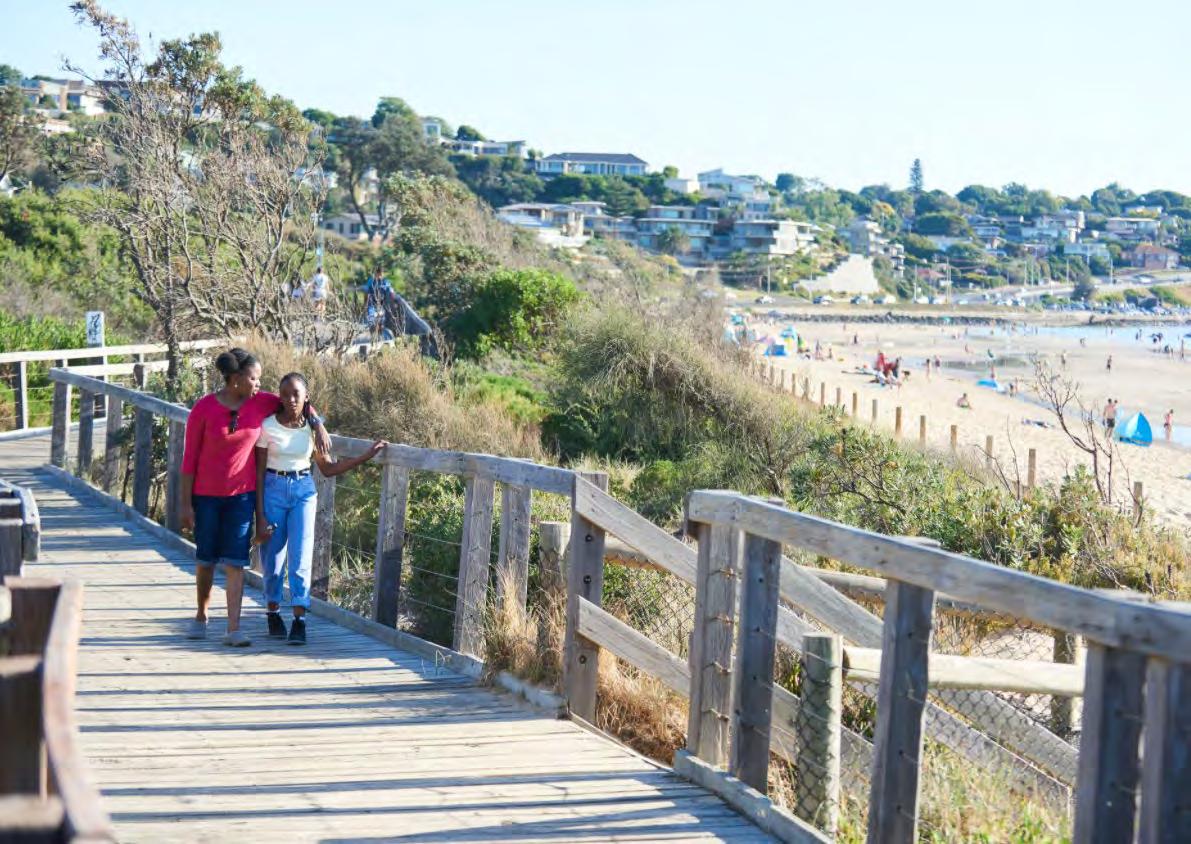
Our community’s aspirations
Opportunities to be physically active
Access to open green space
Fitness equipment in parks and sporting facilities are available in all local areas for people of all ages and abilities to enjoy good health and wellbeing
Universal design principles are applied to infrastructure and public spaces enabling people with disabilities to participate
Improve public transport with commuter bike storage facilities to reduce reliance on cars
Well connected and safe walking cycling shared paths, with improved connections to the beach and between key public spaces
Healthy living is promoted in festivals and events run by Council.
Fresh healthy food is available for all through:
Partnerships with local supermarkets to incentivise fresh and healthy food purchases
Support for growing and sharing of backyard produce Promoting the availability of healthy food choices in Council and community settings
27
Why this is a priority for Frankston City
Participating in regular physical activity has significant benefits for health and wellbeing, including reduced risk of chronic conditions and improved mental health.
• Being involved in sports and recreation improves physical and mental health, and leads to feelings of social connection. v
• Being part of a sporting group enables people from different backgrounds to come together and share a common interest or goal.
• Physically active children and youth are more socially active, have reduced symptoms of depression and anxiety, and perform better at school. vi
• For older people, sustaining or increasing physical activity can help maintain independence, improve digestion and immune function, as well as multiple other mental and physical health benefits. vii
• Physical activity levels vary by social position, with people who are unemployed, have lower levels of education, or living in socioeconomically disadvantaged neighbourhoods being more likely to be inactive or engage in low levels of physical activity. viii
• Inequitable access to supportive walking and cycling infrastructure, green space, community infrastructure and transport options limit opportunities for people to live a healthy and prosperous life. ix
• Our population is ageing and growing in diversity, creating the need for a wider variety of sporting and recreation options. The COVID-19 pandemic has also influenced our sports and recreation needs, placing a greater
emphasis on access to local open green spaces, liveable neighbourhoods and passive recreation activities.
• Access to open spaces supports physical activity, including the provision of facilities that meet the community’s needs. Access to open spaces and natural environments has both physical and mental health benefits. Adults with a wide range of green spaces around their home report 37% lower hospitalisation rates and 16% lower self-reported rates of heart disease or stroke. x
• People who live in walkable neighbourhoods close to natural environments with well-connected paths are more likely to walk and engage in physical activity. The more street trees along the footpath network, the more likely residents are to walk for 60 minutes each week. xi
• Living within walking distance of shops and other facilities increases the proportion of people that walk or cycle, with well-lit streets and footpaths and feelings of safety also contributing to higher levels of active travel xii
• Active travel includes travel by walking, cycling, public transport and other nonmotorised vehicles, and has both health and environmental benefits due to increased physical activity and reduced CO2 emissions.
Our Health and Wellbeing Survey 2020 told us the following would help our residents to be more physically active in open spaces:
Accessible and well connected shared paths
Feelings of safety
More shade provided by tree canopy
28
• Healthy eating and nutrition is important to good health and wellbeing, and reduces the risk of disease.
• A healthy diet helps prevent and manage risk factors such as being overweight and obesity, high blood pressure and high cholesterol, as well as chronic conditions like type 2 diabetes, heart disease and some cancers. xiii
• Most people in Frankston City are not eating enough fruit and vegetables required to keep them healthy. At the same time, we are seeing an increase in obesity and preventable chronic conditions such as type 2 diabetes.
• There is a trend in Victoria for lower fruit and vegetable consumption amongst people who are unemployed and areas with a low SEIFA score. xiv
• Research shows that Australians of all ages are eating too much discretionary food, which is food that’s high in energy and low in nutrients. In Frankston City, 14.4% of adults are consuming sugary drinks daily.
• Whereas being close to a supermarket supports health eating by providing easy access to fruit, vegetables and healthy food, it can still be hard for individuals and families who are under stress to buy, store, prepare and cook healthy options. Some may also be experiencing food literacy barriers.
• Our current food system makes it easy for people to have a poor diet. Our ability to eat a healthy, balanced diet is often undermined by a combination of food system factors. The availability, ease of access and marketing and promotion of unhealthy foods, time pressures to make
convenience food appealing, relatively high cost of healthy foods such as fruit and vegetables and disconnection to food and how it is produced. xv
• A food system includes everything that it takes to get food onto our plate, from farming, storing, transporting, marketing, selling, cooking, eating and then disposing of our food waste (Cardinia Shire Council, 2018).
• Local government is one of many influencers on the food system. A healthy local food system promotes health and enhances the natural environment, improving equitable access to safe, affordable, nutritious and culturally appropriate food.
Our Health and Wellbeing Survey 2020 told us the following would help our residents to eat more fruit and vegetables:
Lower prices
Growing their own at home
Better quality and availability
Food insecurity relates to a lack of healthy food options being available.
• Food security means having access to enough food for an active and healthy life. However, there are people in Frankston City experiencing food insecurity.
• The ongoing effects of the COVID-19 pandemic is impacting food security. The VicHealth COVID-19 Wellbeing Impact Survey found that more Victorians experience food insecurity during lockdown restrictions, with more people relying on a limited range of low-cost unhealthy food and running out of food and unable to buy more.
29
Key facts and figures
Only half (51%) of adults in Frankston City are meeting physical activity guidelines and doing enough exercise to reduce their risk of preventable health conditions
Victorian Population Health Survey 2017
People in Frankston City are highly car dependant, choosing to travel to work by car (76.3%), with 5.9% travelling by public transport and 1.6% walking or cycling.
ABS Census 2016
24.6% of adults in Frankston City spend more than seven hours sitting during an average week day
Victorian Population Health Survey 2017
Only 4.7% of adults in Frankston City report that they are meeting guidelines for the daily consumption of fruit and vegetables
Victorian Population Health Survey 2017
12.5% of households are within walking distance (400m) of public transport with regular 30 minute weekday service, compared to 48% for Greater Melbourne.
Australian Urban Observatory
What we are already doing
• Planning and design of open spaces and play spaces.
• Property and contract management of sports and leisure facilities
• Development and implementation of strategies and plans that align with best practice and emerging trends.
• Maintaining a large public open space network, including over 400 parks, 122 play spaces, 55 nature reserves, 33 recreation reserves/ovals, 11km of shoreline, two gardens and a golf course.
• Maintenance and development of almost 1000km of pedestrian footpath and shared path network, with signage and wayfinding
• Subsidised hire of Frankston Arts Centre for community groups
Bodyweight in increasing, with more than half of the adult population in Frankston City being either overweight or obese (57%)
Victorian Population Health Survey 2017
• Advocating to state government for footpath and shared pathway improvements
• Maintaining 75 sporting pavilions and associated infrastructure, including ovals and lighting
• Supporting over 100 community sporting clubs, with over 30,000 active members
• Capital grants funding to upgrade and build new sporting facilities and open space and play spaces improvements.
• Community grants to support local sport through funding for equipment, uniforms, training and other necessities.
• Traffic and land use planning to support the provision of public transport
30
• Implementing a Healthy Choices Policy.
• Administering permits for food and health businesses
• Delivering community and in-home care services, including shopping and meals preparation.
• Delivering a Meals on Wheels service for eligible residents, providing freshly cooked and nutritious meals
• Making public open space available for community gardens.
• School crossing supervisors to assist children and other pedestrians to safety cross roads
• Maternal and Child Health Service providing advice and guidance on nutrition, breastfeeding and oral health development assessments, education and support for families with children aged 3.5 years and under.
• Supporting Community Support Frankston to provide emergency food relief and grocery vouchers.
Policies Strategies Plans
Health and Wellbeing
Policy
Healthy Choices Policy
Leisure Strategy 2021 –2029
Open Space Strategy 20162036
Play Space Strategy 20212041
Integrated Transport Strategy (to be reviewed)
Sports Development Plan 2013-2019 (to be reviewed)
Local Parks Action Plan 2021-2031
Lighting Frankston Plan 2020-2030
Paths Development Plan
Urban Forest Action Plan
Municipal Early Years Plan 2021-2025
Our objectives and strategies for 2021-2025
1.1 Improve opportunities for walking, cycling and active travel
Implement strategies to improve sustainable transport options that make walking, cycling and active travel easy, safe and accessible
Improve the walkability of our neighbourhoods through accessible footpaths and shared path networks that are connected with local neighbourhoods and key destinations
Build partnerships to deliver community education initiatives and promotional campaigns that encourage walking and cycling and normalise active travel
Better meet the transport and movement needs of the local community within Frankston’s city centre
31
1.2 Improve access to public open spaces, play spaces and recreation facilities
Be responsive to our community’s infrastructure and open space needs
Implement strategies to improve equitable access to a diverse range of high quality open spaces, active recreation and play
1.3 Improve access to inclusive club sports and active recreation activities
Provide inclusive opportunities for all people to be active
Improve community facilities to create more opportunities for inclusive active recreation
Build greater equality and inclusion into club sports to remove barriers for participation
1.4 Improve healthy eating and food security to support good nutrition throughout the life course
Embed healthy food and drink options in council-owned facilities and events
Promote healthy eating initiatives and campaigns that promote nutrition throughout the life course
Facilitate improved access to local, sustainable and affordable healthy food
Build partnerships and networks to promote food literacy, food security and food growing
How we will measure progress
32
Desired result Proportion of adults who are sufficiently physically active Victorian Population Health Survey Increase Proportion of people who are sedentary more than seven hours per day Victorian Population Health Survey Decrease Proportion of adults with chronic diseases and type 2 diabetes Victorian Population Health Survey Decrease Use of public transport, walking and cycling for transport to work ABS Census Increase Proportion of residents who feel safe travelling on or waiting for public transport Annual Community Satisfaction Survey Increase
How we will measure progress
Proportion of residents who feel safe: in public spaces; at night; and during the day
Annual
Proportion of open space and infrastructure to meet community’s needs
Frankston City Council
Proportion of residents satisfied with sport and recreation facilities
Annual
33
Desired result
of
cont.
Proportion
residents who are satisfied with travel options around the municipality
Increase
Annual Community Satisfaction Survey
Increase
Kilometres of footpaths and shared paths Frankston City Council
Increase
Community Satisfaction Survey
Increase
Satisfaction
Increase
Community
Survey
Proportion of adults who are consuming sufficient fruit and vegetables
Increase Consumption of sugar sweetened beverages
Population Health Survey Decrease Proportion of adults who are overweight or obese Victorian Population Health Survey Decrease
Victorian Population Health Survey
Victorian
Building fair and inclusive communities
Our strategic objectives
2.1 Improve opportunities to reduce health inequities, poverty and disadvantage
2.2 Partner and advocate to improve equitable access to education, employment and housing
2.3 Strengthen relationships to support Aboriginal self-determination and reconciliation

Our community’s aspirations
Advocate for high quality healthcare and appropriate accommodation for our ageing population.
A ‘direct point of contact’ referral service within Council to health and wellbeing services for vulnerable people
Greater access to information about First Nations Peoples history and cultural heritage, including the creation of an Indigenous Walking Trail
Accessible Infrastructure and public spaces across the municipality to enable people with disabilities to enjoy greater access and participation.
Incentivise local business to hire and mentor people of all ages and abilities to work within the area.
34
PRIORITY 2
Why this is a priority for Frankston City
Health outcomes and experiences are not the same for everyone and are closely linked to the conditions in which we live and work.
• Income, education, employment and housing are known contributors to health inequalities between population groups. Often, people living in lower socioeconomic areas, people with a disability and Aboriginal and Torres Strait Islander peoples experiencing higher rates of illness, hospitalisation and death than other Australians. xvi
• People reliant on government income support are more likely to report mental health issues and psychological distress. People under the age of 65 who are reliant on social security are more than twice as likely to report mental health conditions (49.9%) and psychological distress (35.6%), than those whose main source of income is wages or salary (18.2% and 9.5% respectively). xvii
• The incidence of certain chronic health conditions, such as asthma, diabetes and heart, stroke or vascular diseases, are more prevalent for those people on low incomes and those who are reliant on government payments for their income. xviii
• The psychosocial stress caused by unemployment has a strong impact on physical and mental health and wellbeing. Once employed, participating in quality work helps to protect health, instilling self-esteem and a positive sense of identity, while providing the opportunity for social interaction and personal development. xix
• Access to secure, suitable and affordable housing is essential to good physical and mental wellbeing.
• In Frankston City, and across Australia, there is decreasing availability of suitable and affordable housing. Unsuitable housing, including overcrowding, tenure insecurity and unaffordability can have serious health impacts.
• People who experience homelessness are among our most disadvantaged. Homelessness can happen to anyone, at any point in their lives. A range of factors can contribute, such as losing a job, suffering illness, mental health problems, family violence, bereavement or relationship breakdown. A lack of affordable housing is a contributing factor in homelessness.
• Aboriginal and Torres Strait Islander peoples experience poorer social and emotional wellbeing outcomes than non-Indigenous Australians, with high to very high rates of psychological distress being nearly three times higher. xx
• Korin Korin Balit-Djak, the Victorian Government’s Aboriginal Health, Wellbeing and Safety Plan, highlights Aboriginal self-determination as being the guiding principle at the core of improving the lives of Aboriginal peoples
• For Aboriginal and Torres Strait Islander peoples, culture is considered to be a key social determinant of health, and includes: connection to country; cultural beliefs and knowledge; language; family, kinship and community; cultural expression; and self-determination. xxi
35
Key facts and figures
11.2% of adults in Frankston City have experienced food insecurity, running out of food and not being able to afford to buy more.
Victorian Population Health Survey 2017
A higher proportion of the workforce is on income support compared to Greater Melbourne. In June 2021, 7.7% were in receipt of JobSeeker and Youth Allowance compared to 6.1% for Greater Melbourne.
Department of Social Services
A lower proportion of school leavers who complete Year 12 go on to education and training (62.8%) compared to the Victorian average (74.5%). On Track Survey, 2019
21% of Aboriginal and Torres Strait Islander peoples hold a vocational qualification as their highest level of educational attainment and the most common occupation is technicians and trade workers (17%).
Australian Bureau of Statistics, 2016
What we are already doing
• Enhanced Maternal and Child Health Service providing short term nursing interventions for families with children aged 0-3 years experiencing vulnerability.
• A range of early years services and infrastructure to support the health and wellbeing of children and families
• Partnering with the Coleman Foundation, Victorian Government and schools to deliver a world-class education system in Frankston North.
• Referring families in the Small Talk Program to health services.
• Inclusive business development, including Mumpreneur workshops and social procurement training.
• Coordination of the Frankston City Job Seeker Alliance.
• Advocacy and referrals for residents that require community and in-home supports.
Frankston City’s homelessness rate has grown at over twice the rate of population growth between 2011 and 2016 (14.7% compared to 6.7%).
Australian Bureau of Statistics, 2016
There are pockets of significant socio-economic disadvantage in Frankston City, with three local areas falling within the lowest 25% of most disadvantaged suburbs in Australia.
Australian Bureau of Statistics, 2016
• Field staff and volunteers monitoring the health and wellbeing of consumers for further assessment and referral.
• Community grants to not-for-profit, charitable organisations and individuals to help them provide important community services.
• Coordination of the Frankston City Strategic Housing and Homelessness Alliance.
• Implementing the Frankston Planning Scheme and Housing Strategy to provide direction for new housing in the municipality.
• Employs a Reconciliation Officer to build awareness and understanding of Aboriginal and Torres Strait Islander peoples.
• Provision of infrastructure for an Aboriginal Gathering Place, Nairm Marr Djambana.
• Assessments of consumers’ needs using the wellness and re-ablement approach to create referral pathways for clients to remain independent and healthy.
36
Policies Strategies Plans
Community Grants
Policy
Learning City Policy
Economic Development
Policy
Housing Strategy
Economic Development Straegy
Municipal Early Years Plan 20212025
Youth Action Plan (to be adopted)
Positive Ageing Action Plan 20212025
Reconciliation Action Plan 20212023
Disability Action Plan 2021-2025
Our objectives and strategies for 2021-2025
2.1 Improve opportunities to reduce health inequities, poverty and disadvantage
Partner to reduce barriers and improve accessibility, inclusiveness and cultural safety of services
Provide accessible information about services, supports and health and wellbeing to support health literacy
2.2 Partner and advocate to improve equitable access to education, employment and housing
Partner to advocate for improved pathways into education, training and employment
Partner to advocate for equitable access to suitable and secure affordable housing
2.3 Strengthen relationships to support Aboriginal self-determination and reconciliation
Acknowledge Traditional Owners as the custodians of our land and Aboriginal and Torres Strait Islander peoples culture as foundational to Frankston City’s identity
Respect and support Aboriginal and Torres Strait Islander peoples self-determination in achieving equitable health outcomes
Collaborate with Traditional Owners and Aboriginal and Torres Strait Islander peoples to advance the reconciliation process, promoting respect, recognition and understanding of cultures and histories
37
How we will measure progress
Proportion of people that had population health screening tests
Victorian Population Health Survey
Proportion of adults who have run out of food and couldn’t afford to buy more
Victorian Population Health Survey
SEIFA ranking of Frankston City LGA and local areas
Australian Bureau of Statistics
Proportion of households living in rental and mortgage stress
Australian Bureau of Statistics
Proportion of housing that is affordable; rental and sales
Australian Bureau of Statistics
Australian Bureau of Statistics
in financial stress
Victorian Population Health Survey
Proportion of children at school entry who are developmentally on track on all five domains of the Australian Early Development Census
Australian Early Development Census
Students achieving national minimum standards in literacy and numeracy
National Assessment Program Literacy and Numeracy (NAPLAN)
Proportion of young people disengaged from education, training and employment
Australian Bureau of Statistics
Achievement of Reconciliation Action Plan priorities
Frankston City Council
PRIORITY 3:
Increasing mental wellbeing and resilience
38
Desired result
Increase
Decrease
Increase
Decrease
Increase
Unemployment rates
Decrease
Proportion of people living
Decrease
homelessness
Decrease
Estimated
count Australian Bureau of Statistics
Increase
Increase
Decrease
Increase
Increasing mental wellbeing and resilience
Our strategic objectives
3.1 Support opportunities to build social networks and community connection
3.2 Increase volunteering and community participation
3.4 Foster social cohesion and community harmony
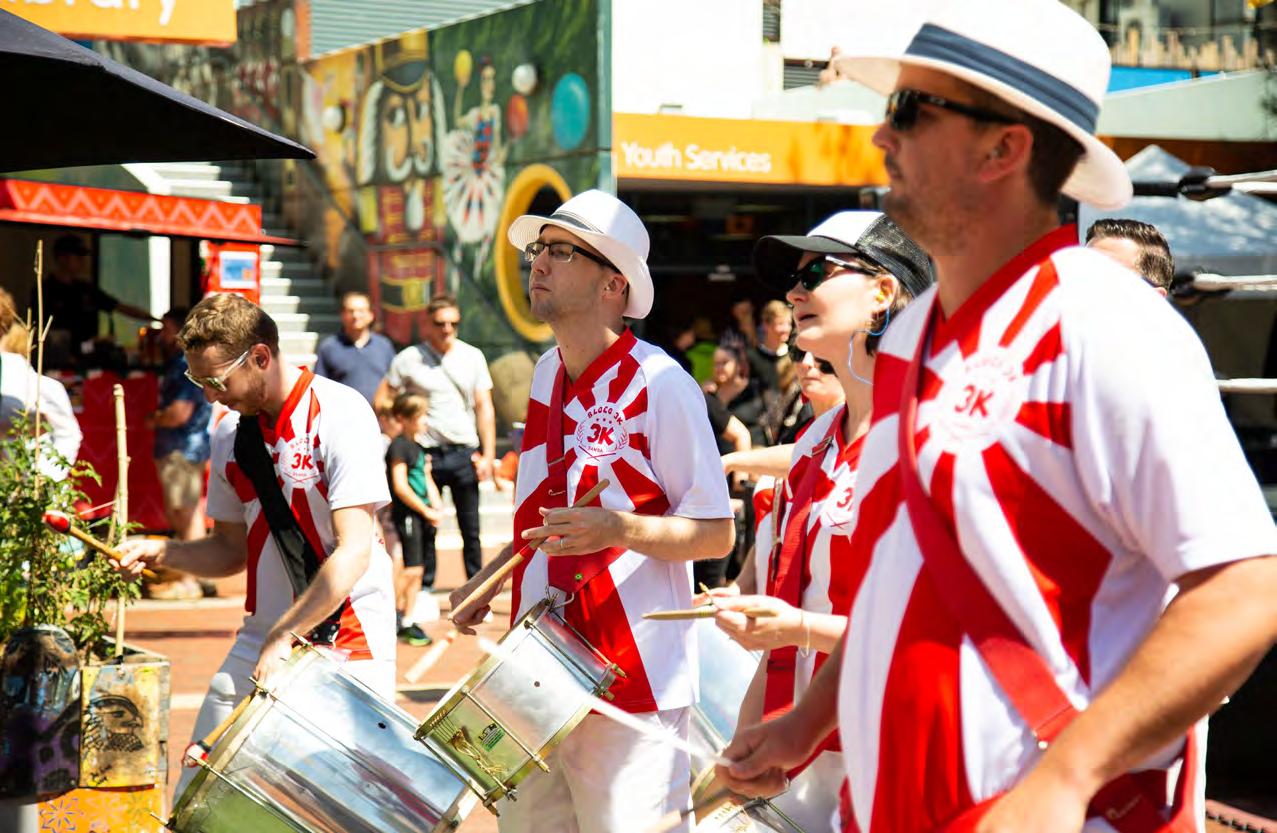
Our community’s aspirations
Thriving arts, events, festivals and programs that celebrate cultural diversity
Council advocates for mental health support for whole families and people supporting a loved one with mental illness
People experiencing mental illness and social isolation are supported through advocacy, referrals and high quality service provision
Well promoted and affordable activities and programs that encourage residents to be connected, including young people
Shared multi-purpose facilities that are accessible and culturally safe to strengthen community connections
People from all backgrounds, ages, cultures, genders and sexualities are represented on committees
39
PRIORITY 3
Why this is a priority for Frankston City
Social and mental wellbeing are important determinants for health and wellbeing across the life course, impacting the ability to participate fully in everyday life.
• A person’s mental health affects how they feel, think, behave and relate to others. According to the World Health Organisation, mental health is a state of wellbeing in which every individual realises their potential, can cope with normal stresses of life, can work productively and is able to make a contribution to their community.
• Almost half of all Australians aged 16 and over will experience mental illness at some point of their life, with the most common conditions being anxiety, depression and substance use disorders.
• Poor mental health can affect anyone at any stage of life. People living with poor mental health are at higher risk of: poor physical health; being unemployed; being homeless; and entering into the justice system.
• Adolescence and early adulthood are peak periods during which mental health conditions first emerge, with 75% of mental health conditions first occurring between the ages of 12 and 25 years. xxiii
xxii Suicide and self-inflicted injuries were the leading cause of burden of disease amongst young people aged 15-24 years.
• Loneliness and lack of positive social connections can have a significant impact on mental health and physical wellbeing Social connection can improve mental health and resilience and reduce stress and depression xxiv
Our Health and Wellbeing Survey
2020 told us that the following would make our residents lives more satisfying:
Better physical health
More sleep and rest
Better mental health
• Social exclusion through discrimination or stigmatisation can cause psychological damage and harm health through long-term stress and anxiety.
• Racism is a key determinant of health of people in culturally and linguistically diverse communities and is harmful to the mental and physical health of those who experience it. Victorian adults who frequently experience racism are five times more likely than those who don’t experience racism to have poor mental health. xxv
• LGBTQA+ people are at increased risk of poor physical and mental health due to experiences of abuse and discrimination, fear of discrimination and internalised stigma and victimisation. 44.8% of LTBIQ+ Victorians have ever been diagnosed with depression or anxiety compared to the 26.7% for Victoria as a whole, and 36% live with two or more chronic diseases compared with the Victorian average of 25%. xxvi
• Spending time in nature helps reduce anxiety, depression and loneliness, while a lack of green space is associated with increased symptoms. xxvii
• Participating in the arts and cultural activities has a positive impact on health and wellbeing, including reducing social isolation and strengthening community connection. xxviii
40
Key facts and figures
Adults are experiencing high to very high levels of psychological distress at a higher rate than many other Victorians – 21% in Frankston City compared to 15.4% for Victoria Victorian Population Health Survey 2017
Over a quarter of households have individuals that live alone (25.3%), with this expected to increase with our ageing population
ABS Census 2016
34.9% of adults have been diagnosed with anxiety or depression at some point, compared to 27.4% for Victoria
Victorian Population Health Survey 2017
Measures of social cohesion are declining, in line with state-wide trends. 43.5% of adults think multiculturalism makes life in their area better, compared to the Victorian average of 53.4%.
Victorian Population Health Survey 2017
What we are already doing
• Maternal and Child Health Service promoting the health and wellbeing of children from birth to 6 years of age, including assessments, support and referrals.
• Supporting community playgroups, providing pop-up playgroups, facilitating Supported Playgroups and including inhome support for eligible families.
• Frankston Arts Centre delivers a diverse program of works and activities, workshops and programs, including outreach arts and culture programs, annual relaxed performances and ticket subsidy program for eligible community members.
• Frankston City Libraries provides opportunities for information, technology and social connection.
• Training in dementia and palliative care for direct care and aged care workers.
Women are experiencing poor mental wellbeing more acutely, with 45.1% of having been diagnosed with anxiety or depression compared to 23.8% of men
Victorian Population Health Survey 2017
33.4% of people regularly help out at a local group as a volunteer, compared the Victorian average of 36%
Victorian Population Health Survey 2017
• Community Transport to shopping centres, Frankston City Libraries and local seniors clubs.
• Frankston City Public Art program, building connection with the arts
• A broad range of inclusive and accessible activities and services that meet community needs, including youth programs, library story-times and Positive Ageing activities
• Community spaces, including neighbourhood houses, community centres, youth hang outs and community meeting rooms.
• Impact Volunteering Service.
• Rolling out changes made as a result of the Aged Care Reform to support the consumer
41
Policies Strategies Plans
Stronger Families Policy
Volunteer Policy
Arts and Culture Strategic Plan 2020-2023
Integrated Housing Strategy (to be adopted)
Municipal Early Years Plan 2021-2025
Youth Action Plan (to be adopted)
Positive Ageing Action Plan 2021-2025
Reconciliation Action Plan 2021-23
Disability Action Plan 20212025
Our objectives and strategies for 2021-2025
3.1 Support opportunities that build social networks and community connection
Facilitate initiatives that support recovery from the COVID-19 pandemic
Support and promote opportunities to build social networks and community connections
Partner to deliver initiatives that build mental wellbeing and resilience
3.2 Increase volunteering and community participation
Strengthen support and capacity building for volunteers and promote volunteering opportunities
Build opportunities for people to engage and influence Council decisions that impact them
Explore opportunities to support community participation in the arts and connection with natural environments
3.3 Foster social cohesion and community harmony
Strengthen our value, inclusion and celebration of Frankston City’s diverse communities
Partner and advocate to promote diversity and address discrimination
42
How we will measure progress
Proportion of adults reporting high to very high rates of psychological distress
Victorian Population Health Survey
Proportion
adults who have ever been diagnosed with depression or anxiety
Victorian Population Health Survey
by
Proportion
people who agree they feel part of the local community
Customer Satisfaction Survey
Proportion of people who agree Frankston is: child friendly; age friendly; accessible and inclusive for people with a disability
Customer Satisfaction Survey
Proportion of people who agree Frankston is welcoming and supportive of people from diverse cultures
Customer Satisfaction Survey
Proportion of people with relatives, or friends, to care for you (or your children) in an emergency
Victorian Population Health Survey
Proportion of people feeling they can have a real say on issues important to them
Victorian Population Health Survey
Number of: members of Environmental Friends Groups; participants in environmental events
Frankston City Council
43
Desired result
Decrease
of
Decrease
Increase
Proportion of people who feel valued
society Victorian Population Health Survey
of
Increase
Increase
Increase
Increase
of people who
Victorian Population Health Survey Increase
Percentage
regularly volunteer
Increase
Increase
4:
PRIORITY
Strengthening climate action for community wellbeing
Our strategic objectives
4.1 Increase awareness of the health impacts of climate change
4.2 Strengthen response to public health threats and emergencies for vulnerable communities
4.3 Support healthy and sustainable homes, buildings and public spaces
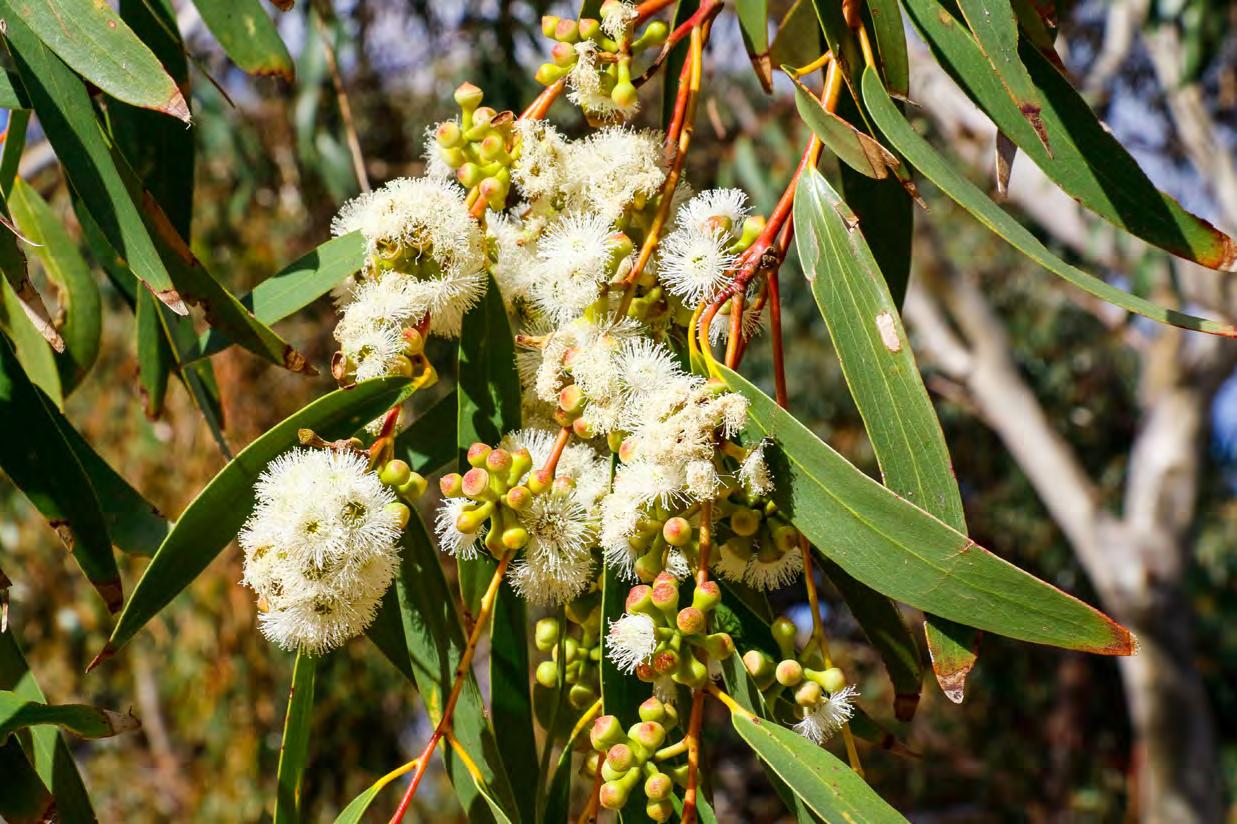
Our community’s aspirations
Greening Frankston City through protection of vegetation and biodiversity, and native tree planting to double our tree canopy by 2040
Reaching a zero carbon footprint on all Council and community buildings by 2040
Programs and education that assist the community and businesses to avoid, reduce, reuse and recycle waste, and to achieve carbon neutrality by 2040
Leading the way on climate change adaptation, encouraging the use of clean, renewable energy to reduce greenhouse gas emissions and protect against sea level rise
Developers use sustainable design principles
44
Green urban areas, clean streetscapes and litter prevention
Why this is a priority for Frankston City
Climate change has been described by the World Health Organisation as the greatest threat to global health in the 21st century.
• The earth is warming at an unprecedented rate as a result of increasing concentrations of greenhouse gases in the atmosphere caused by rising emissions.
• Our health is closely linked to the environment we live in, and our changing climate will have significant consequences for health, wellbeing and safety.
• Victoria is already experiencing direct and indirect health and wellbeing impacts of climate change, including events such as floods, fires and heatwaves, which are occurring at a greater frequency and intensity.
• Direct impacts of climate change are caused by exposure to extreme weather events such as bushfires, droughts, floods and heatwaves and include heat stress, injury, trauma and death. Indirect health impacts include exacerbation of existing chronic conditions like respiratory and cardiovascular diseases, infectious diseases, mental illness, allergies, injuries, poisoning and undernutrition. xxix
• The health impacts of climate change will not be experienced equally The most vulnerable households are likely to be the least able to adapt or manage the risks from climate change, due to poor housing design, fewer financial resources and underinsurance. xxx
• The impact of poor quality and energy inefficient housing on health and wellbeing is an ongoing concern for
Frankston City, exacerbated by the direct impacts of climate change. Of concern is the impact of inadequate protection from outdoor conditions resulting in poor living conditions, higher energy use and more expensive utility bills, contributing to energy poverty and disconnections.
• Young people, Aboriginal and Torres Strait Islander peoples, people with long-term health conditions or disability, people living in low income housing, or people who are unemployed or underemployed are at greater risk of living in poor-quality housing. xxxi
• Adapting to climate change is critical to building community resilience and managing risks. Actions to decrease health impacts can be made through implementing policies, strategies and measures on key determinants of health like transport, parks and open space, land use, housing and waste minimisation. Action across these areas provide opportunities to reduce emissions, support adaptation to climate change impacts and improve health and wellbeing all at the same time. xxxii
• A healthy tree canopy can help absorb heat and reduce the impacts of climate change and absorb the impacts of climate change, as well as improving the liveability of a neighbourhood encouraging people to exercise outdoors.
Both the COVID-19 pandemic and climate change are known to impact certain population groups more than others, contributing to health inequities.
45
Key facts and figures
90% of Victorians haven’t thought about how health is affected by climate change
Sustainability Victoria
Frankston City residents say the most important areas for Council to work to address climate change are:
• Biodiversity and urban forests
• Renewable energy
• Reducing waste to landfill
Frankston City Climate Change Survey 2020
Frankston City’s major emissions source is electricity consumption with the majority of this coming from industrial electricity consumption Snapshot, community climate tool
Key climate change concerns on the local area for Frankston City residents are:
• Loss of biodiversity
• Sea level rise and coastal erosion
• Harsher and longer fire season/bushfires
Frankston City Climate Change Survey 2020
What we are already doing
• Declared a climate emergency calling for urgent action to reverse global warming.
• Providing environmental and waste minimisation education, information and resources for the community
• Ensuring that Council-owned facilities are meeting best practice standards for energy efficiency, renewable energy and water efficiency.
• Frankston Regional Recycling and Recovery Centre
• Providing strategic advice, planning controls and partnerships to facilitate urban development and transport projects that help create low carbon communities
18.8% of Frankston City households have solar installations compared to 21.1 % across Victoria Australian PV Institute, 2021
Frankston City’s tree canopy cover is 17%, which is low compared to other urban areas across Greater Melbourne, contributing to pedestrian exposure to heat
Frankston City Urban Forest Action Plan
• Upgrading 7,000 fluorescent street lights with energy efficient LEDs.
• Managing around 62,000 street trees made up of more than 450 species
• Protecting and enhancing native vegetation cover, habitat value and diversity across public and private land
• Supporting and planning to assist the community to respond to emergencies
• Active member of SECCCA, advocacy to State and Federal Government, project development and delivery
46
Policies Strategies Plans
Environmental Sustainability Policy
Urban Forest Policy
Waste Wise Events Policy
Biodiversity Policy
Environmental Sustainability Design Standards for council buildings policy
Greening Our Future –Environment Strategy 20142024
Climate Change Strategy (to be adopted)
Urban Forest Action Plan 2020-2040
Climate Change Impacts and Adaptation Plan 2011
Biodiversity Action Plan 2021-2036
Towards Zero Emissions Plan 2019-2023
Domestic Wastewater Management Plan
Integrated Water Action Plan 2016-2026
Emergency Management Plan and sub-plans
Our objectives and strategies for 2021-2025
4.1 Increase awareness of the health impacts of climate change
Raise awareness of the health impacts of climate change through strategies on climate change mitigation and adaptation
Advocate for better information on the potential impacts of climate change on health and wellbeing
Facilitate community education programs to increase awareness and climate action
4.2 Strengthen response to public health threats and emergencies for vulnerable communities
Consider the direct and indirect health impacts of climate change in emergency and recovery planning
Support initiatives that build community emergency preparedness and resilience
Provide and promote accessible community spaces for people without adequate heating and cooling
4.3 Support healthy and sustainable homes, buildings and public spaces
Implement initiatives that promote Environmentally Sustainable Design to improve living standards
Support initiatives that enable the community to improve the sustainability of their homes and reduce fuel poverty
Implement measures that reduce the pressure on drinking water supplies
47
How we will measure progress
Community Satisfaction Survey
Proportion
Proportion
Proportion
Australian PV Institute
48
Desired result
Community satisfaction with Council meeting its responsibilities towards the environment
Increase
of tree canopy cover
Increase
Percentage
Frankston City Council
of household waste being recycled
Increase
Victorian Local Government Annual Waste Services Report
of households
with solar installations
Institute Increase
Australian PV
of households with solar installations by areas of socioeconomic disadvantage
Increase
community’s
Decrease
CO2 emissions Ironbark Decrease
of excess deaths relating to heatwaves Coroner Decrease
Frankston City
total greenhouse gas emissions Ironbark
Council’s
Number
Strengthening gender equality and respectful relationships
Our strategic objectives
5.1 Build partnerships to prevent family violence, violence against women and elder abuse
5.2 Strengthen equitable, safe and respectful relationships
5.3 Create gender equitable workplaces, services and programs

Our community’s aspirations
People experiencing family violence will be supported through advocacy, referrals and high quality service provision Council to play an active role in the prevention of family violence through community education.
PRIORITY 5:
Why this is a priority for Frankston City
Violence against women and children is an abuse of human rights that has a devastating impact on health and wellbeing.
• Family violence affects all family members, however data shows that the majority of victims are women and the majority of perpetrators are men.
• Family violence includes violence or threatening behaviour, or any other form of behaviour that coerces or controls a family member or causes that family member to be fearful.
• Family violence carried out against a current or former partner is known as intimate partner violence. Women are experiencing intimate partner violence at a much higher rate than men, with men’s violence against female partners being more likely to inflict severe injury. xxxiii
• Research shows that family violence is more damaging to the health of Victorian women aged 15–44 years than high blood pressure, obesity and smoking. xxxiv
• In Victoria, sexual violence is overwhelmingly perpetrated by men against women. The majority of sexual violence often goes unreported due to the majority of sex offenders being known to their victims. Sexual assault has profound effects on the wellbeing of victim/survivors, including emotional, psychological, legal, health, spiritual and socio-economic impacts. xxxv
• Family violence occurs at higher rates for Aboriginal and Torres Strait Islander peoples than for nonIndigenous Australians, with social disadvantage and intergenerational
trauma being factors for consideration. xxxvi
• Violence against women is largely driven by gender inequality and is preventable. A key way to prevent violence is to strengthen positive, equal and respectful relationships.
• Gender equality is when people of all genders have equal rights, responsibilities and opportunities. Gender inequality is therefore when women and men do not have equality social status, power, resources or opportunities.
• For many people, gender inequality may be compounded by other forms of disadvantage or discrimination that a person may experience due to other intersecting characteristics, such as: ethnicity; Aboriginality; disability; age; sexual orientation; gender identity; and religion.
• Factors like the harmful use of alcohol, socio-economic conditions and exposure to violence can make violence worse, but are not considered to be the underlying cause.
• Research shows that disaster situations result in an increase in the severity and frequency of family violence, and can trigger a change in the nature of family violence already being used or even the onset of family violence.
For many women the COVID-19 pandemic coincided with the onset or escalation of violence and abuse. Victoria Police data shows that reported family violence incidents rose by 11% between Q4 2019 and Q4 2020.
50
Key facts and figures
Women make up 54% of our local workforce and are more likely to hold tertiary qualifications than men, yet women are more likely to earn a low income (43.7%) compared to men (29.1%)
ABS Census 2016
Frankston City has the highest rate of family violence in Metropolitan Melbourne Crime Statistics Agency, 2021
Women are undertaking more unpaid domestic duties than men, with 29% of women doing 15 hours or more per week compared to 9.6% of men
ABS Census 2016
Women are more likely to be to be a victim of intimate partner violence than both men (103.32 per 10,000 compared to 25.12 per 10,000 for men) and other Victorian women (81.6 per 10,000).
Victorian Women’s Health Atlas 2020
What we are already doing
• Maternal and Child Health providing family violence consultations and referrals.
• Implementing a Family Violence Prevention Action Plan.
• Choose Respect, a smart phone app providing respectful relationships advice for young people.
• Participating annually in the 16 Days of Activism campaign to eliminate violence against women and their children.
• Participating annually in International Women’s Day
• Ongoing staff training in family violence and elder abuse
• Field staff and volunteers monitoring for elder abuse.
Women are providing more unpaid caring duties than men, with 13.6% providing unpaid care for a person with a disability, long term illness or old age compared to 9.1% of men, and 33.3% providing unpaid care to children compared to 25.8% of men.
ABS Census 2016
Women are experiencing sexual assault at a far higher rate than men (13.6 per 10,000 compared to 1.7 per 10,000 for men)
Victorian Women’s Health Atlas 2020
• Participating in the Respecting Seniors Network Steering Committee
• Collaborating on World Elder Abuse Awareness Day activities and promotions.
• Working with Peninsula Health to provide secondary consultations on behalf of clients experiencing elder abuse.
• Advocating for seniors through the Age Friendly Frankston Ambassadors.
• Delivering the senior friendly local businesses project to encourage local businesses to be more welcoming and accessible for seniors
• Implementing the Age Care Quality Standards in our service delivery.
51
Policies Strategies Plans
Stronger Families Policy
Child Safe Policy
Family Violence Prevention Action Plan
Positive Ageing Action Plan
2021-2025
Municipal Early Years Plan
2021-2025
Our objectives and strategies for 2021-2025
5.1 Build partnerships to prevent family violence, violence against women and elder abuse
Develop and implement initiatives that prevent family violence, violence against women and elder abuse
Advocate and partner to promote gender equality and prevention of family violence and violence against women
5.2 Strengthen equitable, safe and respectful relationships
Engage the community in programs that strengthen safe and respectful relationships
Engage the community in campaigns that raise awareness of gender equality and attitudes that enable violence and violence against women
Advocate and partner to promote the rights, dignity and independence of older adults
5.3 Create gender equitable workplaces, services and programs
Strengthen gender equality within Council
Ensure Council’s policies, services, programs and facilities are gender equitable, safe and inclusive
52
How we will measure progress
53
Desired result Rate of incidents of family violence recorded by Victoria Police Crime Statistics Agency Decrease Victims of family violence aged 55 plus Crime Statistics Agency Decrease Rate of victim reports of sexual offences Crime Statistics Agency Decrease Proportion of women who spend more than 15 hours per week carrying out unpaid domestic work compared to men ABS Census Decrease Proportion of women who undertake unpaid carer roles compared to men Australian Bureau Statistics Decrease Full-time employment rate Australian Bureau Statistics Increase Occupation Australian Bureau Statistics Increase Gender profile within Council’s workforce Frankston City Council Employment Profile Increase Progress in the achievement of the Gender Equality Action Plan and Gender Impact Assessment Frankston City Council Increase
PRIORITY 6: Building safe communities
Our strategic objectives
6.1 Create safe public spaces through Council policy, planning and design
6.2 Build partnerships that change cultures and reduce harms from alcohol and other drugs and gambling
6.3 Create smoke free communities

Our community’s aspirations
People experiencing gambling harm and social isolation will be supported through advocacy, referrals and high quality service provision
Frankston City is a smoke free City
A safe train station and public spaces within Frankston’s city centre
54
Why this is a priority for Frankston City
Harms from alcohol and other drugs, gambling and smoking all have a significant impact on individual health and wellbeing, as well as the safety and health of the broader community.
• Local government has a unique opportunity to build safe communities and reduce harms through the delivery of universal services, provision of community infrastructure, formation of partnerships and the design and management of public spaces.
• Crime and unsafe behaviours are the result of a complex relationship between social and environmental factors, and cannot be ‘designed out’. However, good urban design of public spaces can be part of a broader approach to improving community safety. If a public space is engaging, comfortable and safe, it is much more likely to be well used and loved, and prevent unsafe behaviours such as crime and alcohol and drug misuse.
• The consumption of alcohol, tobacco and other drugs is a major cause of preventable disease, illness and death in Australia.
• In 2015, 9.3% of the total burden of disease in Australia was due to tobacco use, making it the leading risk factor that contributed to disease burden and deaths. Alcohol accounts for 4.5% of the total burden of disease and illicit drugs 2.7%. xxxvii
• Smoking is highly addictive and harms almost every part of the body, increasing the risk of many diseases, including lung cancer, chronic obstructive pulmonary disease, heart disease and stroke. xxxviii
• Over the last 20 years there has been a significant decrease in smoking rates in
the general population. However, smoking remains to be most prevalent in lower socio-economic groups.
The VicHealth Coronavirus Victorian Impact Study follow-up survey showed that 22% of Victorians who smoke reported they smoked more than usual during the COVID-19 ‘lockdown’ restrictions. Those living alone (38%) and people with a disability (39%) were more likely to report an increase in smoking.
• The consumption of alcohol is widespread, with an established drinking culture prevalent within many social and cultural activities.
• Harmful levels of consumption is a major health issue associated with increased risk of chronic disease, injury and premature death. More than 4,000 people die from alcohol-related injuries, illness and accidents every year in Australia. xxxix
• New alcohol guidelines state that adults should have no more than 10 standard drinks a week to reduce the risk of cancers and have no more than four standard drinks in one day to reduce the risk of injury and accidents.
• Gambling is an activity that affects the quality of life of many people. While many people are able to enjoy the recreational benefits of gambling, there are also many who experience harm. There are links between gambling harm and issues that impact our communities such as poor mental health, family violence, poverty, homelessness and chronic illness. Harm to health caused by ‘low’ and ‘moderate’ risk gambling is greater than that experienced by ‘problem’ gambling. xl
55
Key facts and figures
Residents have lower perceptions of safety than what is average for Metro Melbourne. 70.4% report feeling very safe in public spaces during the day, with concerns around drugs and alcohol (28.1%) being the most common reasons why they feel unsafe.
2021 Annual Community Satisfactory Survey
Each week, 28.5% of adults are putting themselves at lifetime risk of alcohol-related harm due to the amount of alcohol that they are consuming (compared to an average of 24.7% for Victoria)
Victorian Population Health Survey 2017
Adults are being admitted to hospital for alcohol related harm at a much higher rate than what is average for Metro Melbourne (a rate of 869 per 100,000 compared to an average of 549 per 100,000).
Turning Point AODstats, 2018-19
Adults are being admitted to hospital for harm relating to illicit drugs at a much higher rate than what is average for Metro Melbourne (a rate of 446 per 100,000 people compared to an average rate of 278 per 100,000).
Turning Point AODstats, 2018-19
As of December 2020, there were 259 licenced premises in Frankston City, and 514 electronic gaming machines (pokies) in nine gaming venues.
Victorian Commission for Gambling and Liquor Reform
What we are already doing
• Maintaining a high quality CCTV network.
• Activating public spaces to improve community safety.
• Upgrading street lights in Frankston’s city centre
• Local law management.
• Authorises Victoria Police under the Community Local Law and work in partnership to promote community safety
• Implementing the MAV Tobacco Agreement, including tobacco visits, audits and investigations
• Undertake routine monitoring of food premises to ensure food safety and hygiene standards are maintained
More adults in Frankston City are smoking (21.6%) compared to the Victorian average (16.7%), but there are higher rates of people reporting as ex-smokers (29% compared to 24.4%)
Victorian Population Health Survey 2017
• Implementing the Libraries After Dark program to prevent gambling harms.
• Conducting impact assessments of licence applications for liquor and Electronic Gaming Machines
• Ensuring sporting clubs that lease facilities from Council are members of the Good Sports Program and comply with Responsible Service of Alcohol requirements
• Managing festivals and events through an application process to ensure they support low-risk drinking practices
• Trialling pedestrian counters in public spaces to better understand people’s movement and behaviour
56
Policies Strategies Plans
Gambling Policy
Community Local Law
Community Safety Policy (to be adopted)
Community Safety Strategy (to be adopted)
Lighting Frankston Action Plan 2020-2030
Our objectives and strategies for 2021-2025
6.1 Create safe public spaces through Council policy, planning and design
Improve the safety, comfort and enjoyment of public spaces
Develop policies and plans to improve the safety of the community
Implement strategies to encourage a diverse mix of activities in public spaces
6.2 Build partnerships that change cultures and reduce harms from alcohol and other drugs and gambling
Build partnerships to foster collaboration and coordination of harm prevention and minimisation initiatives
Partner to deliver programs that promote safe behaviours and encourage participation in alternative recreational activities
Create healthy environments in Council-owned facilities to prevent harms from gambling and alcohol and other drugs
Partner to advocate on legislative reform and raise awareness of gambling related harm
6.3 Create smoke free communities
Partner to deliver initiatives that encourage smoking cessation and denormalisation of smoking
Minimise harm from and exposure to second-hand smoke through monitoring and education
57
How we will measure progress
Proportion
Victorian
Proportion of people at
risk of alcohol-related injury on a single occasion of drinking
Victorian Population Health Survey
Alcohol-related
Turning
Drug-related
Turning
(alcohol only), per 10,000
Turning Point Alcohol and Drug Data
Rate of illicit drug-related ambulance attendances, per 10,000 total persons
Turning Point Alcohol and Drug Data
Victorian Commission for Liquor and Gambling Regulation
58
Desired result Proportion of adult population that self-report as smokers Victorian Population Health Survey Decrease Number of infringements issued in relation to selling tobacco to minors Frankston City Council Decrease
liquor volume sales Department of Justice Decrease
Total
of
harm
people who consume alcohol who are at lifetime risk of
Decrease
Population Health Survey
increased
Decrease
hospitalisation rate
per 10,000 population
Point Alcohol
Decrease
and Drug Data
hospitalisation rate
10,000
Point Alcohol and Drug Data Decrease
hospitalisation rate
10,000
per
population (illicit drugs) Turning
Drug-related
per
population (pharmaceutical drugs)
Point Alcohol
Decrease
of alcohol-related ambulance attendances
total
and Drug Data
Rate
persons
Decrease
Decrease
of player losses
(pokies)
Amount
on EGMs
in dollars
Decrease


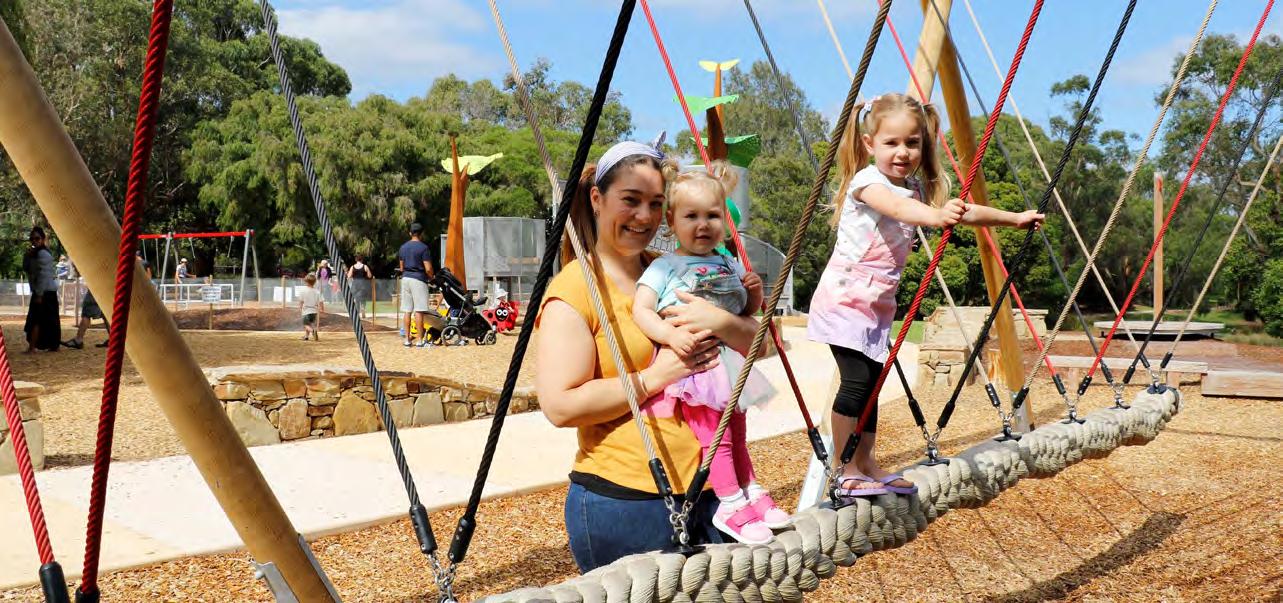
Implementation
The outcomes and priorities outlined in the Plan will be progressed through the implementation of an Action Plan. The actions are prevention-based and outcomes-focussed, aiming to take preventative action at scale within local communities to affect change and impact long-term health and wellbeing. The actions are designed to align with Council’s other strategies and action plans, for collaborative implementation, monitoring and reporting. The actions will focus on the local communities and population groups that are experiencing the greatest health inequalities. Whereas the actions are listed by the Plan’s six strategic priorities, the majority of actions are integrated in that they address more than one priority and outcome, recognising that many health issues share underlying determinants.
Delivering the actions set out in our Action Plan will be a process of continuous improvement allowing for flexible and responsive implementation. As such, the Action Plan will be reviewed and updated annually throughout the Plan’s four-year lifecycle. By doing so, Council will have the opportunity to reflect on the way the actions are being implemented and draw upon evidence in order to make improvements and achieve better results. We will also be able to accommodate any key policy changes occurring at all levels of government, key service system changes, as well as any changing needs of the community.
Monitoring and evaluation
It is a statutory requirement for councils to review their Municipal Health and Wellbeing Plans annually. As such the Plan will be reviewed at the end of each financial year based on progress being made with the implementation of the Action Plan and analysis of any available data.
The Plan will be fully evaluated at the end of the four years, based on the set of indicators outlined for how we will measure progress. These indicators are based on our priorities and have been drawn from Council’s Community Building Outcomes Framework to monitor and assess any change that may be occurring within the seven outcomes across the seven local communities. All indicators that are able to be disaggregated by gender will be.
59
References for statistics and research quoted in the Health and Wellbeing Plan 2021-2025
i Australian Institute of Health and Wellbeing (AIHW) 2016, Australia’s Health 2016
ii Australian Institute of Health and Wellbeing (AIHW) 2016, Australia’s Health 2016
iii Research Summary: Key influences on health inequalities; VicHealth, April 2008
iv Fair Foundations: The VicHealth Framework, VicHealth
v https://www.dlgsc.wa.gov.au/department/publications/publication/the-relationship-between-organisedrecreational-activity-and-mental-health
vi VicHealth Physical Activity Strategy 2018-23
vii Institute of Medicine (US) Food Forum 2010 Providing Healthy and Safe Foods As We Age: Workshop
Summary, Nutrition Concerns for Aging Populations National Academies Press (US), Washington (DC), viewed 20th September, 2021 <https://www.ncbi.nlm.nih.gov/books/NBK51837/>.
viii Institute of Medicine (US) Food Forum 2010 Providing Healthy and Safe Foods As We Age: Workshop
Summary, Nutrition Concerns for Aging Populations National Academies Press (US), Washington (DC), viewed 20th September, 2021 <https://www.ncbi.nlm.nih.gov/books/NBK51837/>.
ix Backholer K, Baum F, Finlay SM, Friel S, Giles-Corti B, Jones A, Patrick R, Shill J, Townsend B, Armstrong F, Baker P, Bowen K, Browne J, Büsst C, Butt A, Canuto K, Canuto K, Capon A, Corben K, … Demaio S 2021 ‘Our path to health for all: Australia in 2030’ Medical Journal of Australia vol. 214, iss. 8.
x Pereira, G, et al. (2012). “The association between neighborhood greenness and cardiovascular disease: an observational study”. BMC Public Health 12: 466.
xi Hooper P, Knuimann N, Foster S and Giles-Corti B 2015 ‘The building blocks of a ‘Liveable Neighbourhood’: Identifying the key performance indicators for walking of an operational planning policy in Perth, Western Australia’, Health & Place vol. 36, pp.173-183.
xii https://www.aihw.gov.au/reports/australias-health/built-environment-and-health
xiii National Health and Medical Research Council 2013. Australian Dietary Guidelines, Canberra
xiv Vichealth Indicators Survey 2015, Frankston City LGA Profile
xv VicHealth website
xvi Australian Institute of Health and Welfare (AIHW) 2020 ‘Built environment and health’, Australia’s Health 2020, Australian Institute of Health and Welfare, viewed 20th September, 2020 <https://www.aihw.gov.au/reports/australias-health/built-environment-and-health>.
xvii De Leeuw, E., Fatima, K., Sitas, F., Naidoo, Y., Treloar, C., Phillips, J., Dorsch, P., Goldie, C. (2021) Work, income and health inequality: A snapshot of evidence, ACOSS/UNSW Sydney poverty and Inequality Partnership Report No. 8, Sydney
xviii De Leeuw, E., Fatima, K., Sitas, F., Naidoo, Y., Treloar, C., Phillips, J., Dorsch, P., Goldie, C. (2021) Work, income and health inequality: A snapshot of evidence, ACOSS/UNSW Sydney poverty and Inequality Partnership Report No. 8, Sydney
xix Australian Institute of Health and Welfare (AIHW) 2020a Australia’s Health 2020, Australian Institute of Health and Welfare, Canberra.
xx Dudgeon Pat, Walker R, Scrine C, Shepherd C, Calma T, Ring I 2014 Effective strategies to strengthen the mental health and wellbeing of Aboriginal and Torres Strait Islander people, cat. no. AIHW 143, Australian Institute of Health and Welfare, Canberra.
xxi Finlay SM, Canuto K, Canuto K, Neal N, Lovett RW 2021 ‘Aboriginal and Torres Strait Islander connection to culture: building stronger individual and collective wellbeing, 2021 ‘Our path to health for all: Australia in 2030’ Medical Journal of Australia vol. 214, iss. 8, s12-16.
xxii Victorian Health Promotion Foundation (VicHealth) 2019 Mental Wellbeing Strategy 2019-2023, Victorian Health Promotion Foundation, Carlton South, Victoria.
xxiii Australian Institute of Health and Welfare, Australia’s Health 2020 Data Snapshot: Burden of disease
xxiv VicHealth 2015, Promoting equality in child and adolescent mental wellbeing, VicHealth
60
xxv Department of Health and Human Services (DHHS) 2017 Racism in Victoria and what it means for the health of Victorians, DHHS Victoria, Melbourne.
xxvi Victorian Agency for Health Information (VAHI) 2020, The health and wellbeing of the lesbian, gay, bisexual, transgender, intersex and queer population in Victoria: Findings from the Victorian Population Health Survey 2017, Victorian Agency for Health Information, Melbourne.
xxvii Maas, J. et al, 2009a, Morbidity is related to a green living environment;, Journal of Epidemiology and Community Health 63(12), pp. 967-973
xxviii Victorian Health Promotion Foundation (VicHealth) 2019a VicHealth Arts Strategy 2019-2023, Victorian Health Promotion Foundation, Carlton South, Victoria.
xxix Department for Health and Human Services (DHHS) 2020 Tackling climate change and its impacts on health through municipal public health and wellbeing planning: Guidance for local government, Department for Health and Human Services, Victoria.
xxx Giles-Corti B, Capon A, Wright A, Harris P, Timperio A, Butt A, Lowe M, Zapata-Diomedi B, Williams C, Pettman T, Gunn L 2021 ‘Physical determinants of health: healthy, liveable and sustainable communities’ 2030 Medical Journal of Australia vol. 214, iss. 8, s12-16.
xxxi Australia’s Health 2020, Australian Institute of Health and Welfare
xxxii Department for Health and Human Services (DHHS) 2020 Tackling climate change and its impacts on health through municipal public health and wellbeing planning: Guidance for local government, Department for Health and Human Services, Victoria.
xxxiii Women’s Health in the South East, Women’s Health Atlas
xxxiv VicHealth, The Health Costs of Violence: Measuring the burden of disease caused by intimate partner violence, 2010
xxxv Women’s Health in the South East, Victorian Women’s Health Atlas
xxxvi Australian Institute of Health and Welfare 2015 Australian Burden of Disease Study: impact and causes of illness and death in Australia in 2015, Australian Institute of Health and Welfare, Canberra.
xxxvii Australian Institute of Health and Welfare, Australian Burden of Disease Study:impact and causes of illness and death in Australia in 2015
xxxviii
Department of Health 2020 What are the effects of smoking and tobacco? Department of Health, Canberra, viewed 20th September, 2021 <https://www.health.gov.au/health-topics/smoking-andtobacco/about-smoking-and-tobacco/what-are-the-effects-of-smoking-and-tobacco>.
xxxix Australian Drug Foundation 2021
xl Browne M, Langham E, Rawat V, Greer N, Li E, Rose J, Rockloff M, Donaldson P, Thorne H, Goodwin B, Bryden G and Best, T 2016 Assessing Gambling-Related Harm in Victoria: a public health perspective, Victorian Responsible Gambling Foundation, North Melbourne, viewed 20th September, 2021 <https://responsiblegambling.vic.gov.au/resources/publications/assessing-gambling-related-harm-in-victoriaa-public-health-perspective-69/>.
61
FRANKSTON CITY
COUNCIL
30 Davey Street
Frankston VIC 3199
Australia
PO Box 490
Frankston VIC 3199
Phone 1300 322 322
+61 3 9784 1888
Fax +61 3 9784 1094
frankston.vic.gov.au
Seaford >> Frankston >> Langwarrin >> Karingal >> Skye >> Frankston South >> Frankston North >> Carrum Downs >> Langwarrin South >> Sandhurst





 Cr Kris Bolam Mayor, Frankston City
Cr Kris Bolam Mayor, Frankston City







































